UK Rare Arc - OPOD
UK Rare Arc - A Spectacular Atmospheric Phenomenon
Have you ever witnessed a circumhorizon arc? This mesmerizing optical phenomenon is one of the largest and most colorful ice halos that can occur in the Earth's atmosphere. While it may be a rare sight in the United Kingdom, it is more common in the United States. In this article, we will delve into the details of the UK rare arc, also known as the circumhorizon arc, and explore why it is a sight to behold.
A Rare Sight in the UK
On June 8th, 2014, Sally Elder captured a breathtaking image of a circumhorizon arc over the Solent in Southern England. This occurrence is particularly rare in the UK, making it a truly special moment for those fortunate enough to witness it. In fact, it is almost impossible to observe this phenomenon in Scotland. However, in the United States, the circumhorizon arc is relatively common, delighting observers with its vibrant colors.
Understanding the Circumhorizon Arc
The circumhorizon arc manifests as a fragmentary rainbow-like band, often filling small cirrus clouds with its spectral colors. This stunning display is caused by sunlight passing through side faces of plate-shaped ice crystals and exiting through the lower near-horizontal face. However, there are specific conditions that must be met for this ray path to occur.
The sun's elevation must be higher than approximately 58 degrees for the circumhorizon arc to form. When the sun is at this angle, the emergent ray grazes the lower face of the ice crystal. Conversely, when the sun is lower, the ray undergoes total internal reflection and no circumhorizon arc is visible. This criterion explains why this phenomenon is more prevalent in certain geographic locations and during specific times of the year.
The Myth of Rarity
Contrary to popular belief, the circumhorizon arc is not an exceptionally rare occurrence. It is, however, highly dependent on the observer's geographic latitude and the sun's position in the sky. In most parts of the United States, where the sun reaches higher elevations, the circumhorizon arc can be seen several times during the summer. On the other hand, in northern Europe, including southern England, this phenomenon may only be glimpsed near noon for a few weeks around the solstice. In Scotland, the chances of observing a circumhorizon arc are significantly diminished, except when looking for a lunar circumhorizon arc.
Distinguishing the Circumhorizon Arc
At times, the circumhorizon arc may be mistaken for another optical phenomenon known as cloud iridescence. However, there are distinct differences between the two:
- The circumhorizon arc exhibits ordered spectral colors ranging from red at the top, transitioning through yellows and greens, and culminating in blues at the base.
- In contrast, iridescent clouds rarely display such orderly and pure color patterns.
Embrace the Beauty of the UK Rare Arc
The UK rare arc, or circumhorizon arc, is a breathtaking atmospheric phenomenon that captivates those lucky enough to witness it. While it may be a rare sight in the United Kingdom, it is a relatively common occurrence in the United States. Understanding the conditions that contribute to its formation and differentiating it from similar phenomena adds to the awe-inspiring experience. So, keep your eyes to the sky and embrace the beauty of this stunning optical display whenever the opportunity arises.
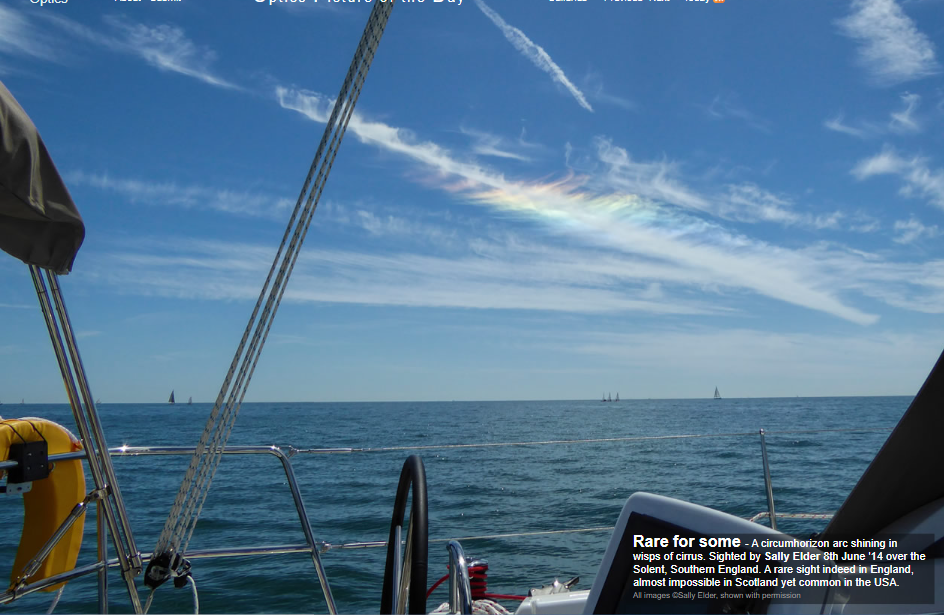
Rare for some - A circumhorizon arc shining in wisps of cirrus. Sighted by Sally Elder 8th June '14 over the Solent, Southern England. A rare sight indeed in England, almost impossible in Scotland yet common in the USA.
All images ©Sally Elder, shown with permission
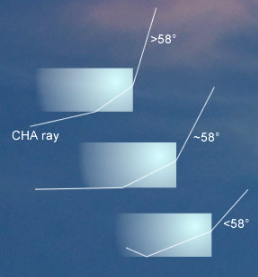
The circumhorizon arc is one of the largest and most colourful of the ice halos. As here, it is often seen only as a fragment filling small cirrus clouds with its spectral colours.
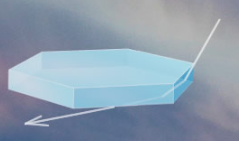
Sun rays enters side faces of plate crystals and leave through the lower near horizontal face.
This ray path is only possible when the sun is higher than ~58°. At ~58° the emergent ray grazes the ice crystal lower face. When the sun is lower the ray is instead totally internally reflected from the lower face and we see no circumhorizon arc.

Rare or Common?
There is an Internet myth that the arc is a very rare even a once in a lifetime sight. Nonsense.
But ease of seeing does depend on location, or more precisely, geographic latitude.
The sun must be higher than 58°. No problem in summer in most of the USA where it might be seen several times.
Northern Europe is different. In southern England, weather permitting, it might be glimpsed near noon for a few weeks around the solstice. In Scotland abandon hope unless looking for a lunar circumhorizon arc.
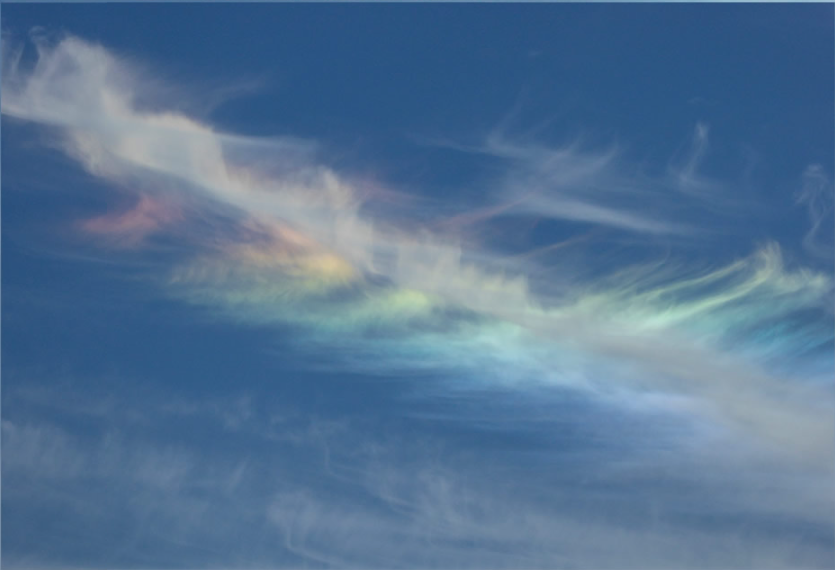
The circumhorizon halo can sometimes be mistaken for cloud iridescence.
The CHA has ordered spectral colours ranging from red on top through yellows and greens to blues at base.
Iridescent cloud colours are almost never so ordered nor so pure.
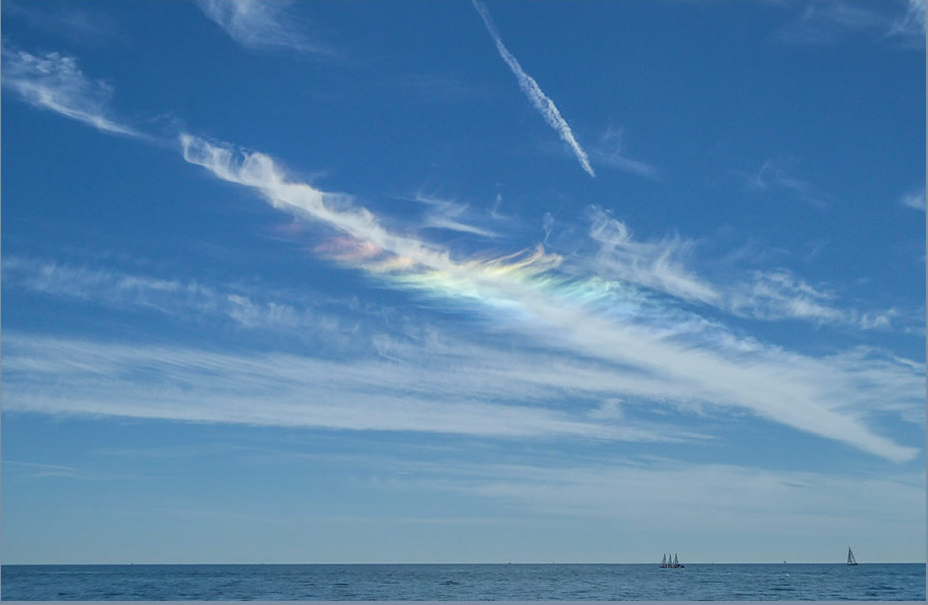
Note: this article has been automatically converted from the old site and may not appear as intended. You can find the original article here.
Reference Atmospheric Optics
If you use any of the definitions, information, or data presented on Atmospheric Optics, please copy the link or reference below to properly credit us as the reference source. Thank you!
-
<a href="https://atoptics.co.uk/blog/uk-rare-arc-opod/">UK Rare Arc - OPOD</a>
-
"UK Rare Arc - OPOD". Atmospheric Optics. Accessed on November 26, 2024. https://atoptics.co.uk/blog/uk-rare-arc-opod/.
-
"UK Rare Arc - OPOD". Atmospheric Optics, https://atoptics.co.uk/blog/uk-rare-arc-opod/. Accessed 26 November, 2024
-
UK Rare Arc - OPOD. Atmospheric Optics. Retrieved from https://atoptics.co.uk/blog/uk-rare-arc-opod/.